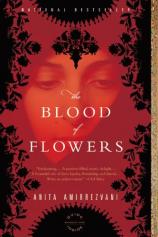The Blood of Flowers
Review
The Blood of Flowers
A
good rug is not just something to tread upon or to keep in the
warmth. A good rug can be a work of art, painstakingly crafted and
beautifully executed. A good rug can also tell a story --- a story
woven into the design or the story of the rug maker. When Anita
Amirrezvani was 14, her father gave her a rug, and she began to
imagine the lives of the people who created it. The dust jacket of
her debut novel, THE BLOOD OF FLOWERS, tells us that from this
experience, the book began to take shape.
Like a fine rug, Amirrezvani's story is tightly woven, balancing
strength and delicacy. It is the tale of a 17th-century young
woman, who remains unnamed, and her journey to emotional and
physical autonomy, happiness and self-worth. When her father dies
unexpectedly, she and her mother leave their small village for the
protection of a relative in the bustling city of Isfahan. Her uncle
(her father's half-brother) is a rug designer and maker for the
Shah, and he knows that his niece has learned the basics of rug
making as well. She is curious to see his studio and learn
from him, but she and her mother become like servants in his
house.
Still, the kindly uncle teaches her more of the craft as he sees
she has a real talent and because he has no sons to whom he can
pass the business off. She is even lent money to create her own rug
in the hopes of selling it but rashly undoes all the knots in a
moment of frustration, prompting her family to enter her into a
sigheh, or temporary marriage.
In this union any pretense of freedom the protagonist has is
shredded, at least for the reader. It is clear to us, if not
immediately to her, that this is a purely sexual relationship; her
family has in fact sold her virginity. Still, she clings to the
hope that it may become a permanent marriage, and in order to
ensure that it does, she commits herself to pleasing her wealthy,
arrogant husband. This storyline has an interesting twist that sees
the security of the young girl threatened once again. Eventually
she learns, after enduring humiliation and loss, that she must
become self-sufficient in order to survive. In this, her passion
for making rugs will serve her well. She finds hope in a seemingly
unlikely home and puts what she learned in her uncle's house to use
in order to take care of herself, her mother and others as
well.
Amirrezvani's heroine is headstrong, likable and sometimes
frustrating as she navigates her relationships and new
surroundings. The unnamed protagonist is well developed but the
supporting characters less so. Still, it is easy to understand her
mother's and uncle's motivation in dealing with her harshly at
times. And, interestingly enough, there are no clearcut villains
--- just individuals who thwart the main character’s
happiness or sometimes treat her unkindly.
THE BLOOD OF FLOWERS brings to life early modern Iran ---
its sights, sounds, tastes and society --- with clarity and
respect, all the while telling an interesting and engaging story.
Amirrezvani also manages to pull off the difficult task of writing
a few sexually explicit scenes without completely straying into the
sappy or the tawdry.
One of the most compelling and interesting aspects of the novel is
Amirrezvani's use of stories within the story. She takes some
Persian folk or fairy tales, as well as a few of her own invention,
and weaves them nicely into the prose. These are stories usually
told among the female characters that express some desire or fear
in a poetic and culturally acceptable way. They lend a sweetness,
richness and authenticity to the tale.
Critics and reviewers are already singing the praises of THE BLOOD
OF FLOWERS, and for good reason. It is a lovely debut; a heartfelt
coming-of-age tale and a historical piece that speaks to issues
beyond its context. Amirrezvani’s prose is readable and her
story enjoyable; the book is better than much summer fare and is
surely a sign of the beginning of a solid literary career. Like the
amazing rugs designed and woven by her characters, this first
novel is strong and beautiful and will stand the test of
time.
Reviewed by Sarah Rachel Egelman on January 7, 2011
The Blood of Flowers
- Publication Date: May 2, 2008
- Genres: Fiction
- Paperback: 400 pages
- Publisher: Back Bay Books
- ISBN-10: 0316065773
- ISBN-13: 9780316065771











